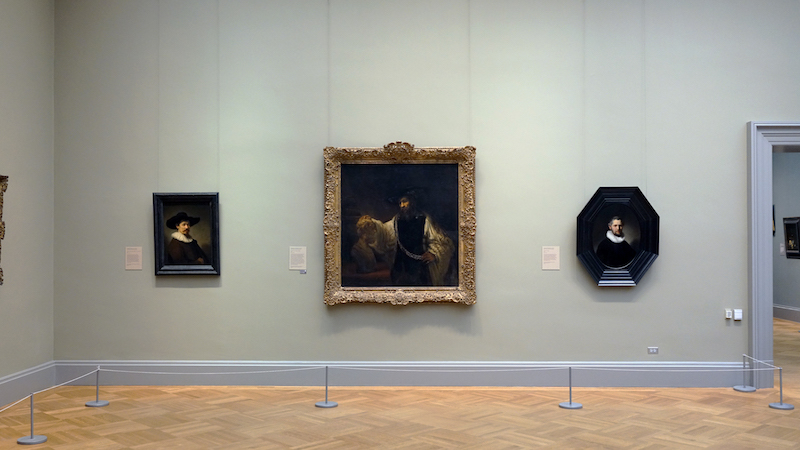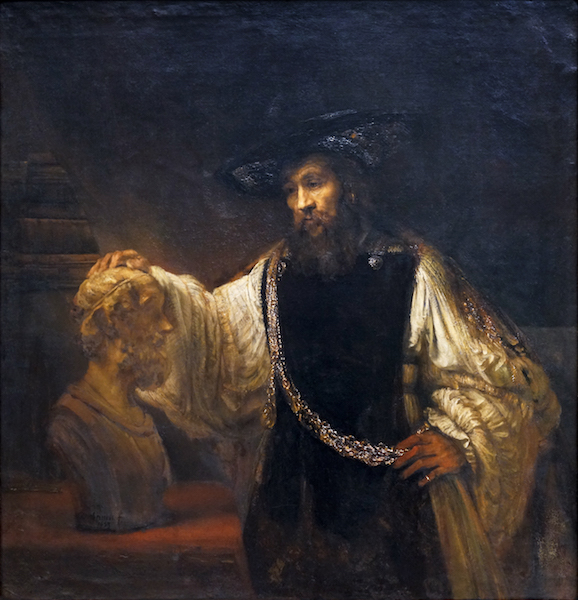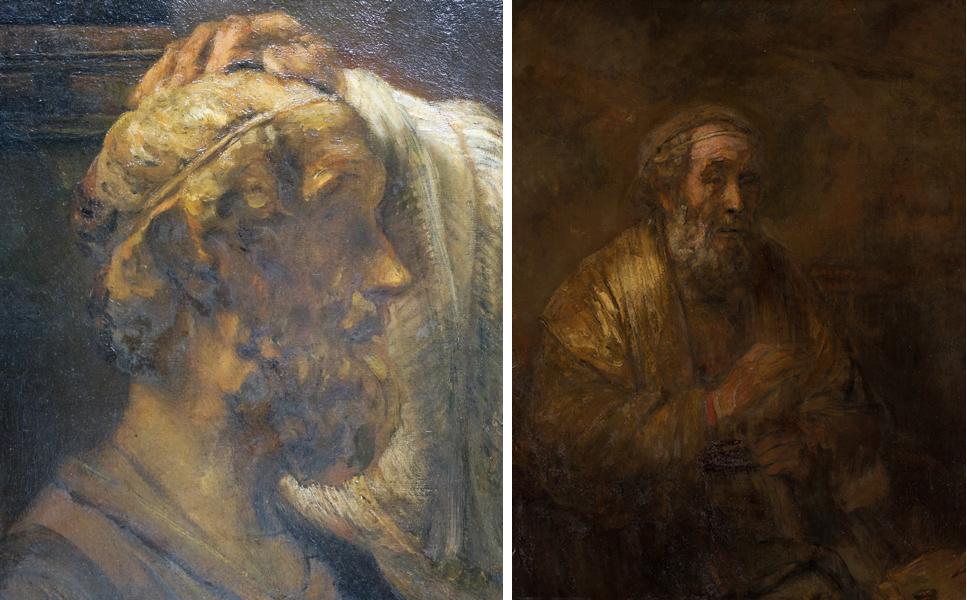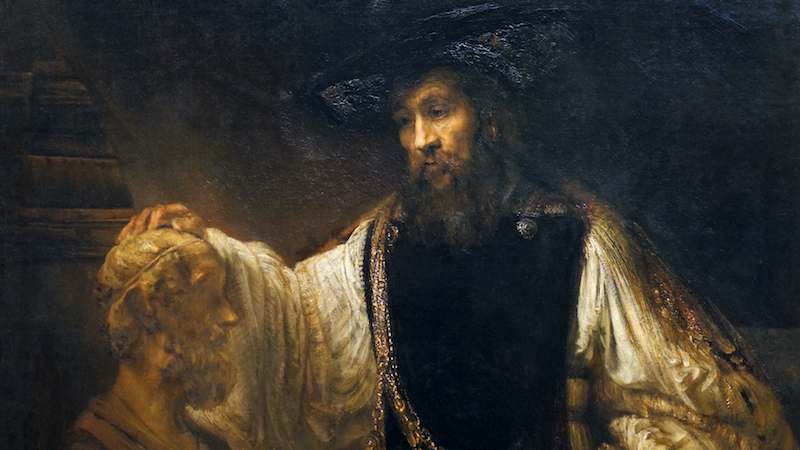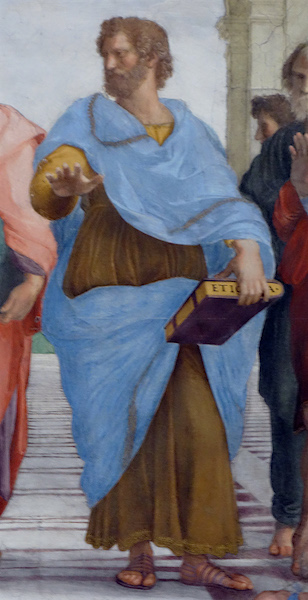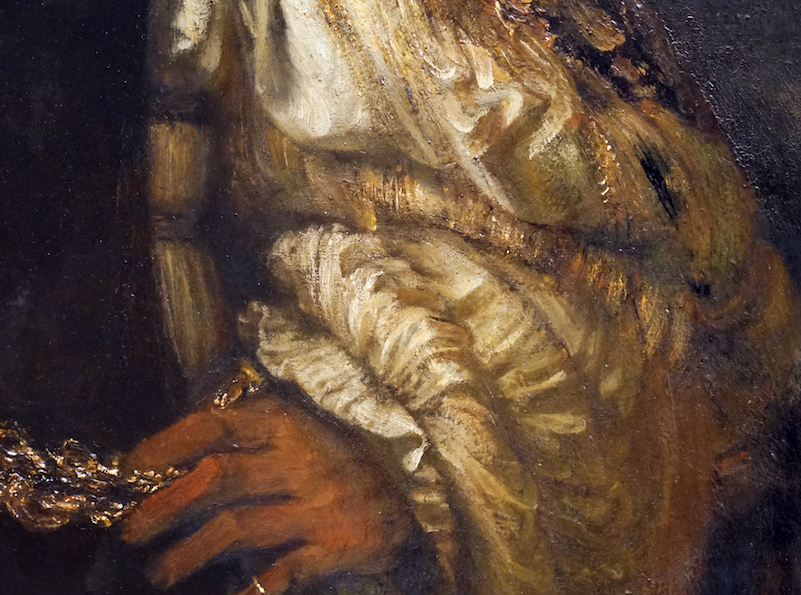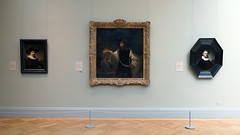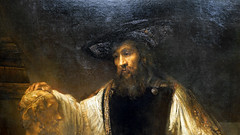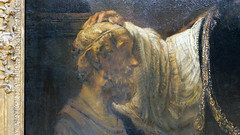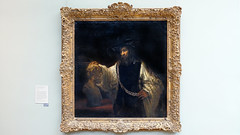Aristotle With a Bust of Homer by Rembrandt
Aristotle With a Bust of Homer by Rembrandt
The conservator's eye, Rembrandt van Rijn'sAristotle with a Bust of Homer, 1653, oil on canvas, 56 i/2 x 53 3/four″ / 143.5 x 136.5 cm (The Metropolitan Museum of Art). Speakers: Jim Coddington and Beth Harris
Center image: Rembrandt, Aristotle with a Bust of Homer, 1653, oil on canvass, 143.five x 136.5 cm (The Metropolitan Museum of Art)
What makes this painting and then captivating?
In 1961, the Metropolitan Museum paid a staggering 2.three million dollars to obtain a tardily piece of work by Rembrandt van Rijn, the painting at present chosen Aristotle with a Bosom of Homer. At the time, it was the well-nigh money ever paid for an artwork. The painting had taken a circuitous route: from Rembrandt'southward studio in Amsterdam to Sicily to London before crossing the Atlantic and finding its domicile in several individual collections prior to auction. Its early travels are well documented, thanks to the survival of shipping manifests and correspondence. The painting now captivates visitors to The Met, equally it has captivated generations of art historians who have argued over virtually every aspect of the painting. What is it that makes this painting and so compelling?
Identifying the subject
The most unremarkably accepted identification of the bailiwick was first assuredly argued in 1969 by Julius Held and refined in the 2007 Metropolitan Museum itemize of Dutch paintings past Walter Liedtke. Based on a suggestion made by the Dutch art historian Abraham Bredius in the 1930s, Held argued persuasively for the identification of the subject as Aristotle contemplating a bust of the bullheaded aboriginal Greek poet Homer (who lived some 400 years prior to Aristotle and who is credited equally the author of the of the ballsy poems the Iliad and the Odyssey).
Rembrandt, Aristotle with a Bosom of Homer, 1653, oil on canvas, 143.5 x 136.5 cm (The Metropolitan Museum of Art)
The identification equally Aristotle is based on the facial features, long hair and beard, jewelry and elaborate dress. They are all comparable with other images of Aristotle produced in both pigment and print in the sixteenth and seventeenth centuries in both northern and southern Europe. Aristotle was held in high regard non just as a poet and philosopher but as well equally an of import commenter on Homer and the instructor of Alexander the Great. Alexander is said to take counted a book of Homer'southward works as one of his prized possessions.
At the time of The Met's purchase, the discipline of the painting was tentatively identified equally Aristotle, only was not yet firmly established. This reflects the defoliation also recorded in seventeenth-century sources. The painting was originally purchased (and perhaps deputed) by the Sicilian prince Don Antonio Ruffo for the hefty sum of 500 florins. Whether information technology was a commission or a purchase is unclear, equally is exactly what Rembrandt was asked to provide. If it was a commission, the choice of subject must have been left to the painter since when it joined Don Ruffo's drove information technology was described as Aristotle or Albertus Magnus (a thirteenth-century German philosopher). This suggests that fifty-fifty the first owner was uncertain of the subject and that decisions most content must take been made exclusively by Rembrandt.
The painting continued to be documented in numerous family inventories until the late eighteenth century. Over the years, information technology has been (mis)identified as "a philosopher," Albertus Magnus, Tasso, Ariosto, Virgil and even the seventeenth-century Dutch poet Pieter Cornelisz Hooft.
Left: Rembrandt, bust of Homer (item)Aristotle with a Bust of Homer, 1653, oil on canvas, 143.5 ten 136.v cm (The Metropolitan Museum of Fine art); right: Rembrandt, Homer, 1663, oil n canvas, 107 x 82 cm (Mauritshuis)
The identity of the sculpted bosom in the limerick was similarly unclear. It was sometimes vaguely identified as representing antiquity, and every bit an attribute of the central effigy. That information technology was intended to correspond Homer tin be supported in several ways.
Almost 10 years after his purchase of this painting, Ruffo would proceed to commission ii more than paintings from Rembrandt: a representation of Homer (remnants now in the Mauritshuis) and one of Alexander (now lost). The Mauritshuis Homer fragment (in a higher place) shows the bullheaded poet isolated, though in its original format information technology would have included the students to whom he was speaking. The living poet in this painting is virtually identical to the bust in Aristotle. The shape of the confront, the framing of the sightless eyes, and the sparse band across his forehead correspond with numerous prototypes and support the firm identification of the bosom every bit Homer. Held has even related it to a specific Hellenistic bust type represented by an instance in the Boston Museum of Fine Arts. Rembrandt himself owned a bust of Homer, as it appears in his 1656 bankruptcy inventory.
Detail, Rembrandt, Aristotle with a Bust of Homer, 1653, oil on canvass, 143.5 10 136.v cm (The Metropolitan Museum of Art)
Aristotle (detail), Raphael, Schoolhouse of Athens, fresco, 1509-1511 (Stanza della Segnatura, Vatican)
Aristotle
In the painting's current state, Aristotle is depicted in 3-quarter length. His right hand extends to rest on the sculpted bosom placed on a table in forepart of a mountain of books partially hidden by a drapery, just he is not looking at the bust. His eyes are fixed on an invisible point outside the frame of the painting, his dark eyes and absent-minded gaze contributing to a feeling of melancholy and detached reflection.
Held associated this melancholy with a passage from Plutarch which recounts that Aristotle had fallen out of favor with Alexander; Liedtke sees the melancholy as an appropriate aspect of a man of learning in the seventeenth century.
Aristotle'due south clothes seem to belong to no particular period, and Rembrandt has eschewed a more traditional, toga-clad approach such as that found in Raphael'southward School of Athens . Aristotle instead seems to wear an odd combination of a wide-brimmed chapeau, a white tunic, and a dark apron-like garment, adorned not only with a gilded chain but earrings and a pinky band. The bust itself is painted in such a warm tone that information technology seems almost more than like flesh than rock, putting the venerable poet about within reach. The 2 thinkers, living and sculpted, are linked non only by Aristotle's gesture, but past the repeated arcs created by their clothing and accoutrements.
The brushwork
Like much of Rembrandt's work from the final third of his life, Aristotle with a Bust of Homer uses the rich darkness of the background to set off the central figure, who is gently picked out from the darkness about as if nether a spotlight. Quick, vigorous brushwork creates the voluminous folds of Aristotle's left sleeve; vivid spots of white and light yellow crest to grade the shimmering surfaces of the chain draped beyond his torso.
Detail, Rembrandt, Aristotle with a Bust of Homer, 1653, oil on sheet, 143.5 x 136.five cm (The Metropolitan Museum of Art)
Though the crux of the painting is the interaction between bosom and man, the highlights and surface texture carry our attention across Aristotle's torso to his left hand which, accented by a ring, rests on the chain at his hip. The background, by dissimilarity, dissolves into obscure and ambiguous darkness, possibly enhanced over fourth dimension.
Medallion (particular), Rembrandt, Aristotle with a Bosom of Homer, 1653, oil on canvas, 143.v 10 136.five cm (The Metropolitan Museum of Art)
Interpretations
Held proposed that hither Aristotle ponders the temporality of worldly success as represented past the golden chain versus the more than profound and lasting benefit of wisdom gained from fine art and literature embodied by Homer's bosom. In this sense, the formal repetition of the arc created by Aristotle'due south chain and Homer's sculpted clothing establishes the 2 figures as counterpoints.
Aristotle's chain bears a medallion featuring a portrait of a man, possibly Alexander the Great. The gifting of gold chains was an aboriginal practice to recognize excellence and service, and had been revived in the early mod period. It is thus both an historical attribute of the figure and an easily recognizable token of honor for the gimmicky viewer. The significance of the chain—both for the subject and in compositional terms—is farther fabricated axiomatic through the care with which it was painted.
In the Poetics, Aristotle addresses, among other topics, how verse, theater, and the arts are processes of mimesis, or imitation of the globe. Through imitating the world in a new format, the poet or painter presents a new vision to the viewer and a new style of knowing the world. In selecting Aristotle as a field of study, Rembrandt commemorated the part of vision—of painting itself—as a noble art.
Perhaps the appeal of the painting derives partly from the mode the viewer is invited to participate and asked to contemplate a bailiwick who, every bit Walter Liedtke wrote, is shown "non every bit a sage from whom wisdom emanates, merely every bit a homo who contemplates ethical bug and puzzles them out for himself."
By enabling the viewer to accept on the Aristotelian function of the one learning by looking, Rembrandt allows the viewer to appoint, like Aristotole, in profound thought. In that regard, it was a perfect piece for an educated, thoughtful collector in the Early on Modern period and remains an invitation to expect and to learn for future generations of visitors to The Met.
Rembrandt van Rijn, Aristotle with a Bust of Homer, 1653, oil on canvas, 56 1/2 x 53 3/four″ / 143.5 10 136.v cm (The Metropolitan Museum of Art).
Video past The Metropolitan Museum of Art
Boosted resources:
This painting at The Metropolitan Museum of Art
Jonathan Bikker, "Contemplation" in Late Rembrandt, Bikker, Jonathan and Gregor J. Grand. Weber, eds. Amsterdam: Rijksmuseum, 2015, pp. 215-233.
Walter Liedtke, Aristotle with a Bosom of Homer, in Dutch Paintings in The Metropolitan Museum of Fine art (New York, 2007, pp. 629-654).
Julius Held, Rembrandt'due south Aristotle and other Rembrandt Studies (Princeton: Princeton Academy Printing, 1969).
Smarthistory images for teaching and learning:
Aristotle With a Bust of Homer by Rembrandt
Posted by: florencebeigues.blogspot.com
